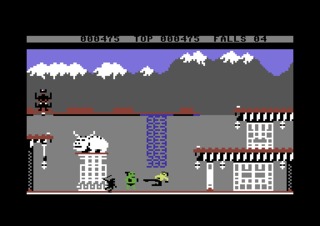
Author: Maddie - Published: 28 July 2025, 9:48 pm
Blackthorne is a cinematic action-platformer developed by Blizzard Entertainment and originally released in 1994 for the SNES. The same year, the game was released for MS-DOS. The SEGA 32X and Macintosh versions arrived later. This dark fantasy adventure represents Blizzard's ambitious attempt to create a narrative-driven platformer that combines the atmospheric storytelling of Prince of Persia with the gunplay mechanics of Contra and the puzzle-solving elements found in games like Another World.
The game follows Kyle Vlaros, also known as Blackthorne, a human raised on Earth who discovers his true heritage as the rightful heir to the throne of Tuul. After the evil sorcerer Sarlac conquers his homeland and scatters the mystical Lightbringer stones, Blackthorne must return to reclaim his birthright and restore peace to his war-torn realm. This narrative framework provides motivation for the journey while establishing a darker tone than typical platformers of the era.
Read More
Author: GN Team - Published: 26 July 2025, 8:53 pm
Road Rash II is a motorcycle racing combat game developed by Electronic Arts and released in 1992 for the Mega Drive/Genesis. This sequel to the original Road Rash represents the pinnacle of the series on 16-bit hardware, combining high-speed motorcycle racing with brutal street fighting in a formula that predates and influences later combat racers like Twisted Metal and Burnout.
The core gameplay builds upon the foundation established by its predecessor while introducing significant improvements that elevate the experience considerably. Players race through five distinct courses representing different regions of the United States, from California's Pacific Coast Highway to the industrial landscapes of Pennsylvania. Each track offers unique environmental hazards and scenic backdrops that create visual variety while maintaining the series' signature sense of speed and danger.
Read More
Author: Maddie - Published: 25 July 2025, 9:03 pm
Disney's Toy Story is a side-scrolling platformer developed by Traveller's Tales and released in 1995 for SNES and Genesis. The game is based on Pixar's groundbreaking animated film. This adaptation represents an example of how movie tie-in games could successfully translate cinematic storytelling into interactive gameplay, drawing inspiration from established platformers like Earthworm Jim while creating its own distinct identity within the crowded 16-bit landscape.
The game follows the film's narrative structure closely, allowing players to experience key moments from both Woody's and Buzz Lightyear's perspectives across multiple gameplay styles. Rather than creating a generic run-and-jump platformer, Traveller's Tales crafted varied gameplay mechanics that reflect each character's unique abilities and personality. Woody levels emphasize his cowboy heritage with lasso-swinging mechanics reminiscent of Bionic Commando, requiring players to master rope physics and timing to navigate vertical challenges and reach distant platforms.
Read More
Author: GN Team - Published: 25 July 2025, 1:24 pm
Super Street Fighter II is a fighting game developed by Capcom, originally released in arcades in 1993 and ported to SNES in 1994. This expanded version of the legendary fighting game series represents the definitive edition of the Street Fighter II formula, introducing four new world warriors and numerous refinements that elevated the franchise to new heights.
The most significant addition to Super Street Fighter II is its roster expansion, which welcomes four distinct new fighters that significantly diversify the combat experience. Cammy brings British special forces precision with her lightning-fast spinning attacks and aerial mobility that rivals those of more acrobatic characters in the King of Fighters series. Dee Jay represents Jamaica with his rhythmic fighting style, combining kickboxing techniques and an infectious personality that makes him instantly memorable. T. Hawk soars in from Mexico as a powerful grappler whose command throws and aerial attacks provide an alternative to Zangief's ground-based wrestling approach. Fei Long channels Bruce Lee's philosophy through his rapid-fire punches and flame-enhanced special moves, offering players a rush-down character that demands aggressive timing and spacing.
Read More
Author: Maddie - Published: 22 July 2025, 5:26 pm
Bruce Lee is a platform beat-em-up developed for Atari 8-bit and published in 1984 by Datasoft. The game created by Ron Fortier (with graphics by Kelly Day) became one of the most memorable and innovative action games of the mid-80s. Its popularity arrived when it was converted for Commodore 64, and given the success, versions for Amstrad CPC, ZX Spectrum, PC Booter, Apple II, and many others also followed.
In the game, you play as the legendary martial arts master as he makes his way through a mysterious fortress full of deadly traps and relentless enemies. Unlike Karateka or Kung-Fu: The Way of the Exploding Fist, Bruce Lee is a platform game. You must explore different screens and solve puzzles. Even its approach to enemy AI and level design is quite unique. Instead of presenting enemies in predetermined positions, like most platformers of the era, Bruce Lee introduces two adversaries - the Green Yamo and the Black Ninja - who appear randomly throughout the fortress and actively hunt you down.
Read More
Author: GN Team - Published: 20 July 2025, 7:15 pm
Soldier Blade is a vertical shoot 'em up developed by Hudson Soft and published in 1992 for PC Engine/TurboGrafx-16. This title represents one of the pinnacles of the genre on NEC's console, offering a pure arcade shooting experience that fits into the tradition of classics like R-Type, Gradius, and Thunder Force III.
The player takes control of a futuristic fighter that resembles '90s jet fighter concepts, navigating through a series of "Operations" that, despite their sophisticated name evoking espionage missions, simply consist of systematically annihilating everything moving on screen. The military nomenclature adds a touch of class to what is essentially a festival of pure destruction, where the objective is to line up your ship with overwhelming forces of enemy fighters, turrets, mech units, battleships, and floating fortresses of every kind.
Read More